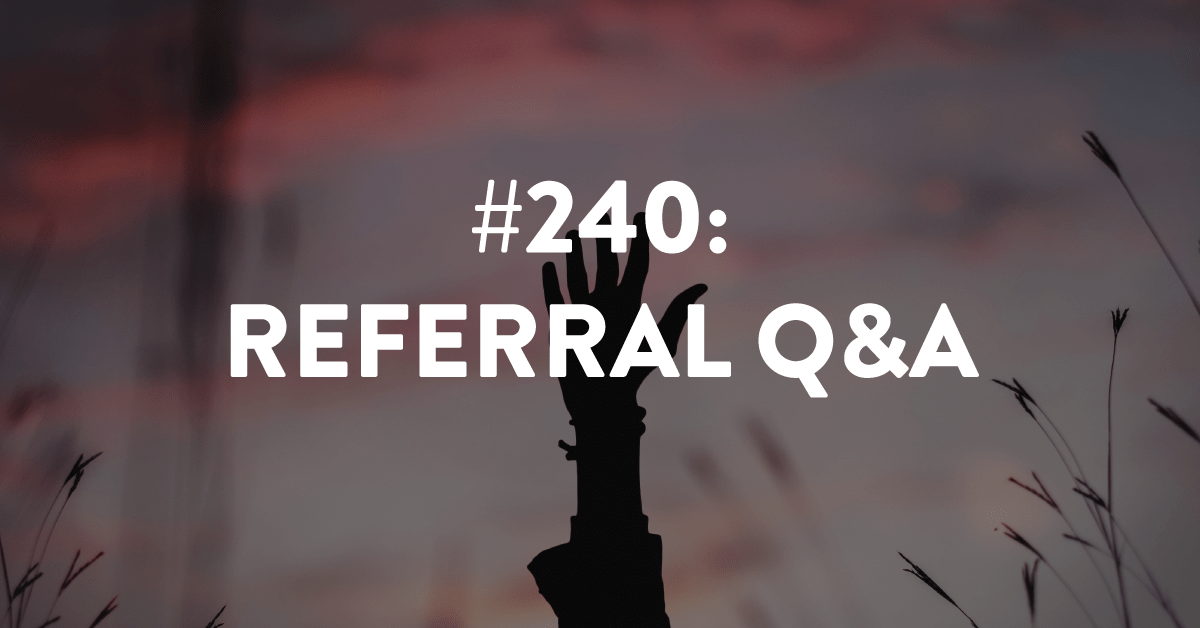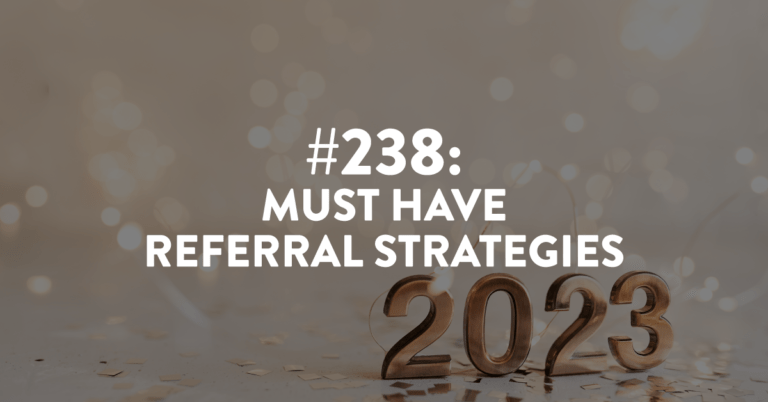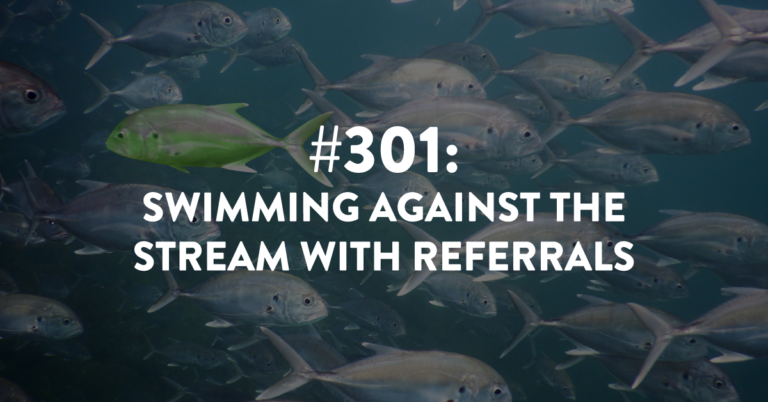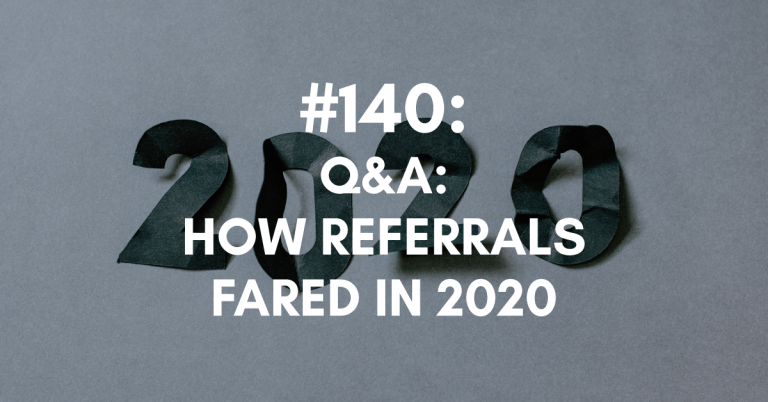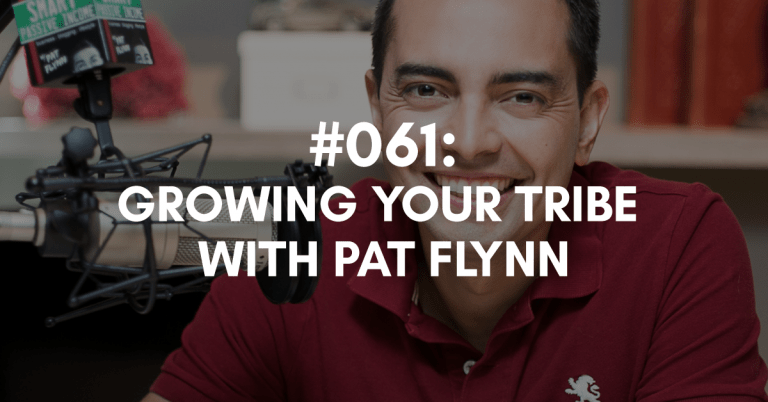Ep #240: Referral Q&A
Every 10th episode, I answer your questions, and today isn’t any different. I will be selecting three questions from my clients, my free Facebook community, Referrals Without Asking, or you (the listeners), and will be answering them to the best of my ability. In this episode, we will cover everything from referral strategies to nurturing referral sources, so stay tuned!
First I will explain how referral strategies work with a team and what it may look like to have multiple employees working under the same brand and executing the same strategies. Next, I will share how long you can expect it to take to nurture a new referral source. Lastly, I will answer a very common question: “When do you know someone is a referral source?”
Links Mentioned During the Episode:
Want to join me for the live training on January 25th on how to follow up with referred prospects? Then check out the group coaching experience, Building a Referable Business™ and submit your application today!
Next Episode:
Next episode is #241, and we’re discussing the importance of noticing referral moments.
Download The Full Episode Transcript
Read the Transcript Below:
Stacey Brown Randall: I have received some awesome questions recently submitted by listeners of this podcast, maybe even you. Let’s dive in. We’re covering a lot of ground today.
Hey there, and welcome to episode 240 of the Roadmap to Referrals Podcast, a show about helping you build a referable business. I’m your host, Stacey Brown Randall.
If you’re a longtime listener of this podcast, then you know this is tradition. Every 10th episode is a question-and-answer episode, where I answer the questions that have been recently submitted by listeners of the podcast or those who are members in my free Facebook community called Referrals Without Asking.
And sometimes, it’s a question I grab from maybe a client or someone who’s recently asked a really good question during one of my virtual presentations, or in-person presentations. So, because this is episode 240, it means it’s a 10th episode and I’ve got some questions that need answers.
For today, we have three questions that I’ll be answering, so let’s dive in.
Question number one: this is a really good question, and to be honest, it’s not for everybody listening, and I recognize this. But for those of you who are in this situation, this is probably a question that you have definitely had. So, I am excited to address it and a little kind of disappointed in myself that I haven’t addressed it prior on the podcast, because I do get this question from time to time.
So, this question is how do your referral strategies work with a team? Such a good question. Okay, so let me provide a little context for this question, and then of course, give the answer.
So, I do have people with pretty great regularity actually, reach out to me and ask about taking the trainings that I do. And instead of just doing it for one person, like a business owner themselves, doing it for their team, and typically, what they mean, is a team of salespeople.
So, they have folks within their organization, and they want those folks to start generating referrals as part of their sales efforts. Now, in the past, this has looked like a group of financial advisors that are all at the same firm and they are each responsible for bringing in their own new clients and they want to do that by referrals.
So, they bring me in and it’s the team. I teach the team what that looks like from a referral-generation perspective. Sometimes, it may be within a larger organization. I have done this before, where I’ve had like 30 or 40 plus people like that are listening to the trainings about referral-generation.
And that may be in that situation, they’re more like W-2 employees of an organization, but they do sales for that organization. So, it could look as if like, “Hey, we’ve got four or five attorneys, and we want you to come in and teach the referral strategies,” or “Hey, we’ve got way more than that or less (whatever) of folks that are employees that we want them to have this tool in their toolbox about being able to generate referrals the way of course, that I teach it.”
And so, the question is usually, when they ask this question about a team — it’s like the logistical piece of like how does the training work? But there’s another part to this question too. So, I want to answer both.
So, the first part is typically, logistically how does that work when you’re teaching a team. But the real question is what does this look like in terms of having a team of people who operate under the same banner of the logo of a company with their referral-generation? So, let me answer both.
Logistically, it depends on what type of training that I am doing. Whether or not we need to limit the size of people in the room so that I can give individualized attention and we can customize what we need to customize, versus if it’s a little bit more of the foundational or generic type, I would say, content that I can provide when I’m just really introducing a team of folks to what I teach.
But for the sake of this argument, let’s just assume this is, I want you to come in and I want you to teach my people, my team, how to implement your referral strategies. So, this would be obviously a paid engagement at that point.
So, we are looking at it from the perspective as I’m coming into the team. And in some cases, I will restrict the number of people in the room just because whereas referrals are not complicated or complex, when you’re thinking about it and learning about it differently, then you’ve probably been beat over the head with for the last couple of decades or generations or so. It takes a little bit of that moment to really grasp, “Okay, wait, this is totally different.”
“We’re generating referrals naturally; okay, now I’m seeing how this would play out in my world. Now, I’m building out what I need to build out for myself and that interaction with me and that feedback with me is really important.” And the smaller the group is, the more we can do. I don’t mean it needs to be small, like 2 or 3 people, but typically we’re going to look around 8 to 12 folks in a group that I would come in and work with.
Have I done larger teams? Because that’s necessary for just how the divisions break down or geography of course. And then we just make sure that we have enough time. Because when I come in to teach a team, just like I do with anybody that goes through one of my self-study online programs or is in my group coaching program, when I’m working with you, there is work that you have to do.
Like there’s usually pre-work you have to submit, there’s typically homework you have to do because we are building a strategy that you will then go and run with. And so, I’ve got to have all the pieces in place, and I got to know you’re on board with me, and you’ve got your pieces in place and build that you can go run with.
So, that’s one of the reasons why it’s not like there’s like hundreds of people hanging out and I’m just teaching a one-size-fits all strategy, and that everyone takes and does and says the same thing as in a whole bunch of robots that walk out of the room when I’m done training.
That’s not what it looks like at all. That’s what actually makes what I do and how I teach it and the strategies that I teach unique. But let’s be honest, it’s also why it works.
So, logistically, usually, we do smaller groups of teams, but those that of course is negotiable and flexible based on just the situation that the company that’s hiring me has kind of found themselves in.
But the deeper question there, and the second part related to that question, is how does the referral strategies like in execution mode and implementation mode — how does that work for my employees or my sales team, or this group of financial advisors or attorneys? How does that work? And it’s all individualized.
When I teach a strategy, I may be teaching the same strategy to everybody, but then they are customizing it and building it out for themselves. So, a lot of people want to be like, “Can you just give my company a referral strategy?” I can give pieces that the company should support and manage, and handle for its employees within the overall referral strategy or referral plan, but not the whole thing.
It’s definitely not going to be the whole thing will be company-driven or company executed. So, there are certainly parts of it that the company can support, manage, handle the budget for, et cetera.
But then there’re going to be other parts where the individual that’s going to be responsible for building and growing and cultivating those relationships with their referral sources, that they’re going to have to do themselves.
So, it’s typically a mix or a blend, but each person walks away with their own plan, so they know what they are doing, even if maybe the second outreach they’re doing is a company event that they’re then, going to invite their referral sources to.
That may be one referral source outreach that all the employees right are doing together. But that doesn’t mean outreach number three will be like that. It may be something very individualized for them. So, it’s really a blend.
There is not a strategy that I can give to a company that like the company marketing or sales leader can execute completely, wholly, fully on behalf of their sales team, of the people who are out there actually generating those referrals and building those relationships with referral sources to receive those referrals.
Absolutely, there’s ways for the company to support them in that endeavor, but every person that needs to receive referrals needs to have their own individualized plan. And some of that has to do with because you’re building relationships with someone else. So, that’s a one-to-one type of environment, but also, because your referral plan needs to fit your personality, it needs to fit just really the industry and the way that you work.
And a lot of other factors kind of go into that. So, that answers the question of like how do the referral strategies work within a team. It is for each person to implement their own, though they may have some crossover where everyone on the team within the company is doing the same thing for some of the outreach, but not for all.
And then, of course, even the language piece at that point will then become similar in some cases, but different in others. And that’s why we keep the training small so there’s that customizable, individualized attention that I can provide so that I know each person building out this referral plan and learning these situational referral strategies to have those tools in their toolbox; they know how they’ll use it in a way that works for them. So, let’s be honest; if it works for them, they will use it.
And then that means in some cases, we have to modify the language and then what we’re doing to fit the person who will be executing on it. So, hopefully, that gives a good answer to that question. Obviously, if you have more questions about that, just reach out to me please.
Pardon the interruption. On January 25th, I will be teaching my BRB members — that’s my Building a Referable Business members — the step-by-step process to follow up with referred prospects from last year that just didn’t commit to working with you.
There is a way to do this correctly, so the referral piece stays intact and works for you as you cultivate those referred prospects from last year and to hopefully, a paying client this year. If you’d like to join me for this live training, there is still time for you to submit your application to join BRB and be onboarded, but don’t delay.
You’ll want to submit that application soon so we have time to process it, and get you official as a BRB member. Just go to staceybrownrandall.com/referable to learn more about BRB and submit your application.
Okay, here’s question number two. How long does it take to nurture a new referral source? Oh, my goodness. When I got this question, which I do hear a lot from my members who are … whether they’re in the Referring Machines online self-study program, they hear me say this. Or if they’re in BRB and they’re going through the Referring Machines training.
That’s the training where we teach people how to cultivate and turn clients and contacts into referral sources. So, getting someone who’s never referred you to actually start referring you. And the question is usually like, “How long does it take to nurture somebody who’s never referred you in to start referring you?”
And here is the answer to that: I don’t know. And I know you’re like, “Wait, what?” That’s because we’re talking about a human on the other end that’s going to go through the process of deciding to refer you when they’ve never done it before, and quite possibly, never even considered it before.
Which means every person that makes the decision to put their reputation on the line and send a new client your way, that journey for every person to go from never thought about referring you to now, I’ve referred you, and want to do it more — that journey is different for every person. And I think it’s really important to respect that journey that each person is going on.
So, let me give you two examples. And instead of like giving names of my clients, I’m just going to use what they do.
So, this is like what I would call the interior designer versus the real estate agent. It’s not really a versus, it’s just two examples of like how long this can sometimes take and how fast this can sometimes work as well.
So, when you decide that you need to really get serious about having new people refer you. Okay, I need new referral sources, I need new people referring me; typically, the two places that people look first is the clients that they have, whether they’re existing clients like active right now, or they’re alumni clients, they’re previous clients that they used to work with.
And then they look at centers of influence. Centers of influence, sometimes we call them COIs. There are people who know what you do, they don’t do what you do, so there’s no competitive overlap, but they also come across your ideal client with some level of regularity to be able to refer you.
So, when people are like, “Hey, I need some new people referring me,” those are the two places I tell folks to start. Let’s identify clients that could be referring you, and let’s identify centers of influence that could be referring you.
And then I teach a process. It’s like a first conversation running five, keeping warm. And that’s the process I teach inside Referring Machines, of how we go about identifying those folks and then cultivating them through the process, including follow-up to getting them to the point where they will actually refer you.
So, I had an interior designer who was really looking to get more referrals from architects, which is super smart. So, a center of influence strategy to get architects to refer clients to her. And this interior designer like was really good about maintaining the process.
And she did receive a referral from an architect. It was a brand new referral source for her, this architect. It was someone that she had gone through the Referring Machine process and really cultivated that relationship, and it took 16 months.
Yep, I like to be real. It took 16 months, but that 16 months of that journey that interior designer went on to get that architect to refer to her was worth $620,000 — 6-2-0,0-0-0, over $600,000. Totally worth the 16 months. And more referrals should then continue to come from this architect. And if they’re like that, well, that’s golden.
So, 16 months, that may sound like a really long time, but that’s actually a very distinct strategy that this person took, this business owner took because she knew the type of clients that she wanted to be referred to her and she knew that this person and people like that architect could provide it. So, she got serious and she made the commitment, and it paid off, but it took 16 months.
On the other hand, I have a real estate agent, and I actually have lots of these stories, so I just picked two. But I had a real estate agent that was like, “Okay, I’m going to start cultivating new referral sources.”
And in like 30 days, he had a brand new referral source. He was like, “Whoa, that was fast.” I’m like, “Yes, that is actually very fast.” But the truth is that person, it only taking 30 days to refer them for the first time after they started that cultivation process — what I told him and what he realized was that they were either like really on the cusp of referring you, it just wasn’t brought to the forefront for them or obviously for you to know that.
Or as you started your cultivation process, an opportunity just popped up, and boom, you were the receiver of that. You got the benefit of that because there it is. You started the cultivation process; now, you’re top of mind with them, and then here’s an opportunity to refer you, and they do it. So, 16 months, 30 days, somewhere in between, longer, shorter. There’s not an easy answer to how long it takes to nurture a referral source.
What I will tell you is what I teach inside Referring Machines, is that once you’ve identified somebody to refer you; you’re going to cultivate them through our running five, keeping warm follow-up process for a full year before you decide that maybe they aren’t the right fit to refer to you.
And it doesn’t mean they won’t refer to you in the next year. It just means that we’re not going to shortchange them the experience of that cultivation to become a new referral source until we’ve done at least 12 months.
That doesn’t mean we’re doing something every month. So, let me clarify that — I just mean that that’s the timeframe, that’s the time container that we set for it. Some people will do that for two years, and that’s their timeframe container.
I teach a minimum of one year. But definitely based on your business, based on how easy it is or how a little bit more difficult it is to get new people to refer you obviously, takes that time. And some of this has to do with like how long have you been in business as well.
Sometimes somebody being willing to refer the attorney who’s six months in business and running their own firm and six months being an attorney, will take longer than somebody who’s been in business 15 years.
So, like, there’s just a lot of factors that come into play. And that’s one of the things that I love: having those discussions about people inside BRB, the coaching program when they’re going through the Referring Machines training, is then we get to get really clear on, “Okay, because you’re an attorney, let’s look at it this way. Because you’re an architect, let’s look at this way. Because you’re an executive coach or a marketing consultant, let’s look at it this way. Because you’re a financial advisor and this is your niche area of clients, let’s look at it this way.’
So, there’s always some ability. You’ve got to have the ability to take what the training is and apply it to your world and your application. So, it does take some time and space to think through those things. And of course, the coaching program provides that because then you have access to me every week to ask those questions. So, okay, let’s move on.
Question number three: when do you know someone is a referral source? Great question. You would think that everyone would be like, “Yeah, they’re a referral source” and then it gets all muddy. So, let’s answer it. It’s a really simple answer.
Someone is a referral source once they have referred a new potential client to you. Not when they say they have talked about you to somebody else who needs to hire you. Though, at that point, you can start counting them as a referral source, but you haven’t actually gotten a referral from them because you haven’t actually been connected to the prospect they’ve been telling you to, you about.
So, there’s a lot of muddiness here in terms of when is somebody a referral source? And we know that somebody’s a referral source once they have actually referred a potential client to you. And referring a potential client to you means that there is a prospect. That potential client as a prospect, has a need that you can solve and is interested in talking to you about it, and you’re being connected by the referral source to that prospect.
So, when those two things happen, you have a referral, and that’s what makes somebody a brand new referral source, is when they refer you, make that connection to that prospect for the very first time.
Now, you can definitely have somebody make an introduction or a warm lead or word-of-mouth buzz, and that flips itself into a referral. And then, you of course, will count that person as a referral source at that moment. Even if that word-of-mouth buzz flips itself into a referral without you doing anything.
So, for example, if you’re having a conversation with someone, they’re like, “Oh, by the way, I talked to an old colleague from an old company where I used to work. He’s now at this company, definitely needs to hire you. I gave him your contact information, he’s going to reach out.” That’s not a referral. It’s word of mouth buzz right at that moment.
And so, obviously, I teach in the moment, how do you flip that into a referral. But let’s just say for this example that then the very next day that prospect called you and said, “Hey, I was talking to your both mutual friend, and he said I needed to call you.”
Well, at that minute, that word-of-mouth buzz flipped itself into a referral because the prospect reached out to you without the referral source making the connection. So, we would count it then as a referral source.
So, again, there’s nuances here in terms of how we track things and the metrics. And it usually matters because of the tracking and the metrics that you have this stuff clear. You can operate your life without having it that clear.
But just know that a referral source is officially a referral source when they refer you their first client. They’re no longer a potential. They are now an existing referral source.
Okay, so those were three great questions. I loved having the time to answer them.
Remember coming up, every 10th episode, we do a question and answer. So, if you have a question that you want to hear me answer on the podcast, more so than just answering over email or answering it in our free Facebook community, Referrals Without Asking. You want to hear my verbal response, of course, the best way to do that is submit your question to me, ask your question, and then I pull these to be answered on the podcast.
And of course, all the resources we talked about today are available on the show notes page for this episode, which you can find at staceybrownrandall.com/240. That’s for episode 240, and Stacey has an “E.”
Real quick before I let you go; if you want to join me and the other members of the BRB coaching program on January 25th for the live training on how to follow up with your referred prospects from last year, then submit your application ASAP so we can review it to make sure you’re a good fit for BRB. Go to staceybrownrandall.com/referable to learn about BRB and submit your application now.
Coming up next week is episode 241, and we’re going to be discussing the importance of noticing referral moments.
Until then, you know what to do, my friend. Take control and grow your business. Bye for now.

